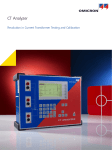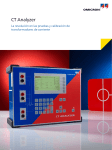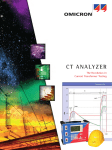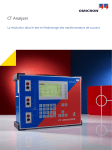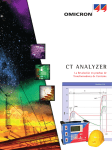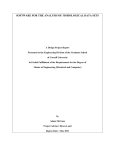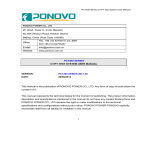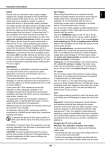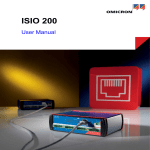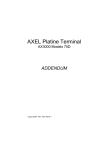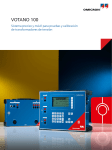Download CT Analyzer Brochure English
Transcript
CT Analyzer The Revolution for Current Transformer Testing and Calibration World Leader in Innovative Power System Testing Solutions THE UNIQUE CT ANALYZER OMICRON’s CT Analyzer delivers a unique capability for the fast comprehensive testing and calibration of current transformers, for protection and metering engineers as well as CT, switchgear and transformer manufacturers. The equipment provides automatic testing and calibration for all types of low leakage flux current transformers both on-site in the power system as well as in production facilities and test labs of manufacturers. A wide range of measurement functions can be provided: • Measurement of CT ratio and phase angle accuracy with consideration of nominal and connected burden • CT phase and polarity measurement • CT winding resistance measurement • CT excitation/saturation recording • Secondary burden measurement • Transient behavior measurement for CTs where this behavior is defined, such as TPS, TPX, TPY and TPZ. The CT Analyzer is the first device that can carry out this test. • Determination of accuracy limiting factor (ALF), instrument security factor (FS), secondary time constant (Ts), remanence factor (Kr), transient dimensioning factor (Ktd), knee point voltage/ current, class, saturated and non saturated inductance FEATURES & BENEFITS • Extremely small and lightweight (< 8 kg / 17 lb), particularly beneficial for on-site testing. • Reduced commissioning time due to fully automatic testing. Results within seconds. • Calibration of measuring transformers: A typical accuracy of 0.02 % / 1’ enables field calibration and verification of class 0.1 CTs for metering. • Allows testing of CTs for power frequencies from 16 to 400 Hz. • Automatic parameter search and analysis of CTs with unknown data. • High level of safety - all tests use low voltages (120 V). • Automatic creation of test report in ten selectable languages. • Precise measurement of ratio error and phase displacement up to x-times the rated current and for all burden values without the need to connect burden hardware, independent of the application (e.g. bushings and GIS). • Test of CTs with very high knee-point voltages (up to 30 kV). • Automatic demagnetization of the CT after the test. STANDARD COMPLIANCE The CT Analyzer can automatically assess whether or not a CT complies with the applicable international standard, thereby indicating if the characteristics of the CT are appropriate for its application. Automatic assessment is available according to: • Institute of Electrical and Electronics Engineers (IEEE) standard: IEEE C57.13-1993 Standard Requirements for Instrument Transformers • International Electrotechnical Commission (IEC) standards: IEC 60044-1 Instrument Transformers - Part 1: Current Transformers and IEC 60044-6 Instrument Transformers Part 6: Requirements for Protective Transformers for Transient Performance 2 TESTING AND ASSESSING A PROTECTION CT A protection CT is used to produce a secondary current proportional to the actual current flowing in the power system. This is then used as an input signals to the system protection. The magnitude of the current may range from several milliamps to up to 30 times the rated current. In order for a relay to operate properly, the protection CT must have a linear characteristic, over its specified operating range. The CT can be driven into saturation by too much primary current, excessive secondary burden, or currents with a high dc offset (e.g. transformer inrush current). Since the operation of the relay can become unpredictable during CT saturation, the excitation or saturation characteristic of the CT is a very important consideration for the relay engineer. A protection CT is specified by an accuracy limiting factor (ALF) which the relay engineer can use to choose the correct CT for the application. The ALF is determined by the excitation/ saturation characteristic of the CT, its winding resistance and the secondary burden resulting from the connecting leads and the attached relays. It is therefore important to measure all of the parameters and determine the ALF for a particular connected burden. The CT Analyzer automatically measures these parameters and determines the value of the ALF. It also calculates the accuracy limiting factor according to the connected burden (known as the ALFi) and assesses whether the CT meets its nameplate specification. This helps the relay engineer to determine on-site whether the CT meets the protection design criteria. The excitation/saturation voltage of a protection CT can range from hundreds of volts to more than ten thousand volts. Testing at these high voltages requires special safety procedures and considerations. The CT Analyzer uses a variable frequency, low voltage method for the excitation/saturation test. If the voltage required is higher than 120 Vac, then the frequency is reduced to achieve the same level of excitation. The final results are then transformed back to the nominal frequency. This method allows testing of a protection CT with a very high kneepoint voltage at safe voltage levels, therefore lowering the safety risk to the operator. In special relay applications, a protection CT with a specified transient behavior according to IEC 60044-6 can be used (e.g. TPY, TPZ). The CT Analyzer is the first device that can automatically test and assess whether the CT complies with this standard, thereby indicating if its characteristics are appropriate for the relaying application. TESTING A MEASUREMENT CT TO ACCURACY CLASS 0.1 Ratio errors arise because a proportion of the primary current magnetizes the core instead of being transferred to the secondary winding. Electricity meters can only measure the signals they receive from a measurement CT and so depend on its accuracy. The accuracy class of a measurement CT has been defined in the relevant international standards, depending on the installed burden and the actual percentage of the nominal current. The CT Analyzer is the first device that can automatically determine whether the performance of the CT is compliant with the relevant IEC or IEEE standard. Its high accuracy enables the testing of measurement CTs of all accuracy classes on-site - including classes 0.1 and 0.2. When the magnetic flux within a CT reaches a certain value, its core will saturate. Saturation protects a measurement device against heavy overcurrents. Thus, it is critical for the safety of the device that the actual burden is known. The CT Analyzer is the first device that can automatically determine the ratio error and the instrument security factor (FS/FSi) for all load conditions. 3 METHOD I: PRIMARY NOMINAL CURRENT INJECTION METHOD II: PRIMARY CURRENT INJECTION CT as a "black-box" IP CT as a "black-box" IS IS IP current source, amp meters, phase meter, reference CT, burden box, etc. A ADVANTAGES OVER METHODS II & III: >2 t ADVANTAGES OVER METHOD I: +Precise results as magnetic losses are accounted for ~ 30 kg +Can be used for on-site calibration DISADVANTAGES: - Time consuming - Unless a burden box is used, burden is not considered and no burden dependent results can be obtained (e.g. ratio, FS, ALF, etc.) does not consider burden - Requires heavy equipment such as large cables, current booster equipment, etc. - Test has to be performed for each desired burden value suitable for on-site calibration +Easy to use DISADVANTAGES: - A lot of equipment is involved considers burden +Small test device - No assessment to relevant IEC or IEEE standards is possible - Cannot be used for on-site calibration *)Determination of the knee-point voltage is limited to the available output voltage *)Determination of the knee-point voltage is limited to the available output voltage unsuitable for on-site calibration V kneepoint limited*) V kneepoint limited*) 4 METHOD III: SECONDARY VOLTAGE INJECTION METHOD IV: CT ANALYZER EXPERT MODELING CT as an electrical model CT as a "black-box" VP V VP VS V 1. Definition of CT model elements with variable frequency 2. Calculation of CT parameters through embedded mathematical functions ADVANTAGES OVER METHOD I: ADVANTAGES OVER METHOD I: ~ 30 kg does not consider burden unsuitable for on-site calibration +Small test device 8 kg +Easy to use ++Small test device ++Easy to use DISADVANTAGES: ADVANTAGE OVER METHOD III: - Burden is not considered, therefore the test does not allow an assessment of burden on CT ratio and phase accuracy nor accuracy limiting factor or instrument security factor ++Independent from mains frequency considers burden - Tests normally take place at nominal frequency and are therefore depending on electrical noise, as the measured primary voltage has very low values (especially critical for measurements in substations or power plants) - No burden dependent results can be obtained (e.g. ratio, FS, ALF, etc.) - No assessment to relevant IEC or IEEE standards is possible -- CTs for export to countries with different mains frequency can easily and precisely be measured -- Mains frequency noise is suppressed - ideal for on-site measurements ADVANTAGES OVER METHODS II & III: Determination of all the elements in the CT model: suitable for on-site calibration - Cannot be used for on-site calibration V kneepoint limited*) VS (f) *)Determination of the knee-point voltage is limited to the available output voltage V kneepoint up to 30kV 5 ++From the CT model, ratio and phase accuracy can be determined for any burden - burden box is not needed ++Many parameters defined in the relevant IEC and IEEE standards can be measured and assessed (e.g. FS, ALF, Kr, εC, Kssc, Ktd) ++Can be used for on-site calibration (verified by German National Metrology Institute - PTB) ++Very high knee-point voltages (up to 30kV) can be measured with low output voltage – with OMICRON’s patented variable frequency method BENEFITS FOR TESTING METERING CLASS CTs • Burden dependent ratio and phase error results without the need for external burden box POWER • Extremely high accuracy without external reference CT*) • Automatic calculation of Ratio Correction Factor (RCF) VA cos Phi 15 0.8 7.5 0.8 3.75 1 0 1 Current ratio error in % at % of rated current Data type 1% 5% 10% 20% 50% 100% 120% 200% String value -0.023 -0.023 -0.021 -0.018 -0.013 -0.010 -0.009 -0.008 Float value -0.023 -0.023 -0.021 -0.018 -0.013 -0.010 -0.009 -0.008 String value -0.008 -0.010 -0.010 -0.008 -0.006 -0.004 -0.003 -0.002 Float value -0.008 -0.010 -0.010 -0.008 -0.006 -0.004 -0.003 -0.002 String value 0.005 0.001 0.000 -0.001 0.000 0.000 0.001 0.001 Float value 0.005 0.001 0.000 -0.001 -0.000 0.000 0.001 0.001 String value 0.007 0.005 0.004 0.003 0.003 0.003 0.004 0.004 Float value 0.007 0.005 0.004 0.003 0.003 0.003 0.004 0.004 POWER • High noise immunity for on-site testing • Automatic class assessment based on IEC/IEEE standards*) *) full accuracy available in Advanced Package AUTOMATIC ASSESSMENT: VA cos Phi 15 0.8 7.5 0.8 3.75 1 0 1 Phase displacement in [min] at % rated current Data type 1% 5% 10% 20% 50% 100% 120% 200% String value 1.76 1.14 0.84 0.57 0.27 0.10 0.06 !0.16 Float value 1.76 1.14 0.84 0.57 0.27 0.10 0.06 0.16 String value 1.42 1.01 0.80 0.59 0.34 0.19 0.16 0.08 0.08 Float value 1.42 1.01 0.80 0.59 0.34 0.19 0.16 String value 1.34 1.03 0.87 0.68 0.46 0.31 0.28 0.20 Float value 1.34 1.03 0.87 0.68 0.46 0.31 0.28 0.20 String value 1.04 0.82 0.70 0.57 0.39 0.28 0.25 0.18 Float value 1.04 0.82 0.70 0.57 0.39 0.28 0.25 0.18 Burden dependent ratio and phase error results 1 Determining whether or not a CT complies with a relevant international standard requires the measurement and/or calculation of many different CT parameters - and a lot of experience. Automatic measurement/calculation of parameters • Ratio (up to 99 000 : 1) • Current ratio error and phase error for all measurement points defined in selected standard • Winding resistance • Excitation/saturation voltage current • Secondary burden • Saturated inductance (Ls) • Unsaturated inductance (Lm) • Remanence flux factor (Kr) • Secondary time constant (Ts) • Accuracy limiting factor (ALF / ALFi) • Instrument security factor (FS / FSi) • Dimensioning factor according to class PX, TPS (Kx) • Accuracy limiting voltage/current according to class PX (Ek / Ie) • Turns ratio according to class PX (N) • Turns ratio and composite error (εt , εc) • Rated symmetrical short-circuit current factor (Kssc) • Transient dimensioning factor (Ktd) • Peak instantaneous error (ε^) • Maximum emf voltage (Emax - calculated value) • Accuracy limiting voltage/current (Val/Ial) • Secondary terminal voltage rating (Vb) • Knee-point voltage/current (Vkn / Ikn) The core of OMICRON's collected expertise is included in the CT Analyzer. The CT Analyzer is designed to accurately determine and display all relevant parameters, compare the measured results to the requirements of the selected standard, and to deliver an automatic assessment of the CT's compliance within seconds. The CT Analyzer is the first device with such capabilities. 6 BENEFITS FOR TESTING PROTECTION CLASS CTs • Excitation/saturation testing with safe voltages (max 120Vac) using patented variable frequency method • Testing with actual burden connected at site - verification of CT performance under actual conditions • Testing of transient parameters for TPS, TPX, TPY, TPZ CTs*) • Testing of high knee-point voltages of up to 30 kV*) • High noise immunity for on-site testing *) available in Advanced Package High knee-point voltages of up to 30 kV 2 Comparison of results to standard 3 Automatic assessment IEEE C57.13 Results shown on the Assessment Card IEC 60044-1 IEC 60044-6 7 "GUESSING" NAMEPLATES If the nameplate data are no longer available, the CT Analyzer can determine that data if it is correctly connected to the CT. Thus an older CT can confidently be put into service without the need to contact the manufacturer. The CT Analyzer then performs a complete CT test and ascertains all relevant parameters using patented technology. Parameters determined include type (measurement or protection), class, ratio, nominal and operating burden, cos ϕ, winding resistance, and knee-point of the CT. In addition, the current ratio error and the phase error are determined at nominal burden for different currents and powers, both given in percent of their rated values. SIMULATION FOR DIFFERENT BURDENS AND CURRENTS1 Existing measurement data can be loaded at any time to recalculate the test results for different burden values and primary currents. This way, no further on-site measurements are necessary to verify whether a changed burden influences the behavior of a CT. Recalculation of ratio and phase accuracy for defined burden and current values, based on the CT Analyzers measurement results of a CT, can also be performed on a PC with an Excel application, which is part of the delivery. Thus re-calculation of the test results can easily be performed back in the office using the existing test reports. MULTIMETER WITH INTEGRATED SOURCE: QUICKTEST Test engineers often need to perform manual tests for troubleshooting or quick verification purposes. QuickTest allows the CT Analyzer to be used as a multimeter with integrated current or voltage source. With QuickTest, the CT Analyzer can perform a wide variety of measurements which are usually necessary for fault finding (measurement of L, Z, ratio, polarity, burden etc.). QuickTest is also available as a PC tool. The QuickTest Interface was added to the CT Analyzer packages in 2009. Users who purchased CT Analyzer at an earlier date can upgrade their device with a QuickTest license. 1Part of the Advanced Package. 8 NETWORK SIMULATION Correct CT parameters are often required for accurate modeling of power systems in network studies and simulation testing of protection relays. NetSim is a software tool for network simulation using OMICRON’s three-phase relay test sets.CT Analyzer can export its measurement data to NetSim, which then builds its simulation on measured CT data instead of just nameplate data/ values. This is especially useful in analyzing the behavior of protective relays due to CT saturation. Network simulation software NetSim showing a CT saturation REMOTE CONTROL FOR FULL PRODUCTION INTEGRATION With the remote control it is possible to integrate the device in a fully automated test environment. The device can be completely controlled from a PC. A test can be defined, started and the results can be imported back into Excel™, where customer-specific test reports and templates can be prepared. The remote control also allows for writing a customer-specific user interface. For an easy start with creating the remote interface, working samples are delivered with the device in Visual Basic and C++. REPORTING All results are saved on a removable Compact Flash card and can be transferred to a PC for further processing, viewing and printing (e.g. Excel™, Word™, Microsoft HTML). Excel™ Report templates are available for different standards, classes and applications, including single core CTs, multicore CTs, or three phase test. Via the templates the user interface and report language can be changed "instantly", e.g. for testing in one language and printing in another. The test report is available in ten different languages - selectable by the user. So for e.g. project companies it is easy to provide the test report in their clients' language - independent in which language the test was performed. The templates can be modified by the customer. Included report templates 9 STANDARD PACKAGE ADVANCED PACKAGE • On-Site/Off-Site Measurement of: ----- • All options of the standard package, plus: all types of protection CTs with connected burden all types of measurement CTs bushing CTs and CTs within a GIS CTs considering the connected burden • Automatic assessment of compliance: -- with IEC 60044-1 and/or IEEE C57.13 for CTs of accuracy classes 0.2 and 0.1 -- with IEC 60044-6 for CTs with defined transient behavior • Automatic assessment of compliance with IEC 60044-1 and/or IEEE C57.13 for CTs of classes > 0.2 Features Features • CT ratio measurement with consideration of nominal and connected secondary burden • CT phase and polarity measurement • CT excitation/saturation characteristic recording • CT winding resistance measurement • Secondary burden measurement • Measurement of ratio, ratio error and phase displacement at currents of up to 400 % the rated value and for different burdens, without the need to (re-)connect burden hardware, independent of the application (e.g. bushings and GIS) • All options of the STANDARD package, plus: • Determination of the following CT parameters: -- Accuracy limiting factor (ALF) -- Instrument security factor (FS) -- Secondary time constant (Ts) -- Remanence factor (Kr) -- Knee-point voltage/current -- Saturated and non saturated inductance • Assessment according to defined standards IEC 60044-1 and/or IEEE C57.13 • Small and lightweight (< 8 kg / 17 lb) • Short testing time due to fully automatic testing with results in seconds • Allows testing of CTs for power frequencies from 16 to 400 Hz • High level of safety due to using low voltages for all tests (max. 120 V) with patented variable frequency method • Measuring CTs with knee-points from 1 mV up to 4 kV • Automatic demagnetization of the CT after the test • "Nameplate guesser" function for CTs with unknown data (see page 8) • QuickTest (see page 8) • Remote control interface (see page 9) • Display readable in bright sunlight • Automated determination of transient dimensioning factor (Ktd) • Automatic assessment according to IEC 60044-1 and/ or IEEE C57.13 for CTs of all accuracy classes, including 0.2 and 0.1 • Simulation of measured data with different burdens and currents (see page 8) • Measurement of the transient behavior of CTs where this behavior is defined, such as TPS, TPX, TPY and TPZ, according to IEC 60044-6 • Measurement of knee-point voltages of up to 30 kV Automated calculation of Ktd with (OMICRON) and without remanence (IEC 60044-6). 10 ORDERING INFORMATION ADVANCED PACKAGE Standard Package plus additional options as detailed on opposite page. (VE000654) STANDARD PACKAGE (VE000656) CT Analyzer with standard set of accessories (see table below). QuickTest Upgrade (VESM0652) QuickTest software license upgrade (for firmware versions prior to v3.50). ACCESSORIES (PART OF STANDARD & ADVANCED PACKAGE SCOPE OF DELIVERY) Coax cables with banana plugs, 2 x 3 m, 1 x 10 m (VEHK0651) Battery clamps with 4 mm banana sockets for primary side connection (VEHZ0652) Grounding (PE) cable, 1 x 6 m, 6 mm², for protective earth connection (VEHK0615) Crocodile clamps for secondary side connection with 4 mm banana sockets, 20 mm opening width, 2 x red, 2 x black (VEHZ0656) Flexible terminal adapters with 12 x 4 mm banana socket (VEHS0009) USB - RS232 converter cable with Nullmodem cable (VEHZ0014) Compact Flash card 128 MB for at least 416 test reports of memory space (VEHZ0654) USB 2.0 Compact Flash card reader (VEHZ0655) Power cord (country-dependent) User manual (VESD0605) CT Analyzer carry bag (VEHP0018) CT Analyzer PC software toolset (remote control software, QuickTest, Excel File Loader, etc.) (VESM0800) Training CT, 300:5, class 0.5 FS 5 (VEHZ0643) Coax cable with Kelvin clamps, 3 m (VEHK0657) Pluggable 23 turns winding (VEHK0658) CT Analyzer Calibration CT, 2000:1 / 2000:5, class 0.02 (VEHZ0649) Coax cables with banana plugs 3m (VEHK0654), 6m (VEHK0652), 10m (VEHK0653), 15m (VEHK0655), 100m (VEHK0656) Transport case with wheels (VEHP0068) ADDITIONAL ACCESSORIES 11 (countrydependent) OMICRON is an international company serving the electrical power industry with innovative testing and diagnostic solutions. The application of OMICRON products provides users with the highest level of confidence in the condition assessment of primary and secondary equipment on their systems. Services offered in the area of consulting, commissioning, testing, diagnosis, and training make the product range complete. Customers in more than 130 countries rely on the company’s ability to supply leading edge technology of excellent quality. Broad application knowledge and extraordinary customer support provided by offices in Europe, North America, South and East Asia, and the Middle East, together with a worldwide network of distributors and representatives, make the company a market leader in its sector. With its policy of pioneering development OMICRON continues to lead the field in creating solutions to meet the needs of 21st century customers. TECHNICAL DATA CTs that can be measured with the CT Analyzer Measurement CTs Advanced Package: all classes Standard Package: classes 0.3/0.5 or higher (according to IEEE C57.13 / IEC 60044-1/) Protection CTs Advanced Package: all types Standard Package: all protection classes defined in IEEE C57.13 1993, and all conventional types defined in IEC 60044-1, such as 5P, 10P, PX, PR (CTs with defined transient behavior according to IEC 60044-6 only with Advanced Package) CT ratio up to 99000:1 (or @:5) CT knee-point 1mV - 30kV (Advanced Package) OMICRON Sales Service Centers 1mV - 4kV (Standard Package) CT nominal frequency 16 - 400 Hz Ratio accuracy (for 0 VA up to rated power) ratio 1 - 2000 0.02 % ratio 2000 - 5000 0.03 % ratio 5000 - 10000 0.05 % Phase measurement Resolution 0.1 min Accuracy 1 min (cos ϕ 0.8 ... 1) Winding resistance measurement Resolution 1 mW Accuracy typical 0.05 % / guaranteed 0.1 % + 1 mW Supply voltage Nominal voltage 110 - 240 V ±10 % 50 / 60 Hz (500 VA) Permissible range 85 - 265 V Americas OMICRON electronics Corp. USA 12 Greenway Plaza, Suite 1510 Houston, TX 77046, USA Tel.: +1 713 830 4660 1-800-OMICRON Fax: +1 713 830 4661 [email protected] www.omicronusa.com Asia-Pacific OMICRON electronics Asia Ltd. Suite 2006, 20/F, Tower 2 The Gateway, Harbour City Kowloon Hong Kong S.A.R. of China Tel.: +852 2634 0377 Fax: +852 2634 0390 [email protected] www.omicron.at User interface Display readable in bright sunlight Operation numerical keyboard and functions keys Data storage & transfer to PC Card type Compact Flash card Mechanical data Weight 8 kg / 17.4 lb (without accessories) Dimensions (W x H x D) 360 x 285 x 145 mm / 9.2 x 7.2 x 3.7 inch Europe, Middle East, Africa OMICRON electronics GmbH Oberes Ried 1 A-6833 Klaus, Austria Tel.: +43 5523 507-0 Fax: +43 5523 507-999 [email protected] www.omicron.at © OMICRON L144 Subject to change without notice. Last update: October 2009













